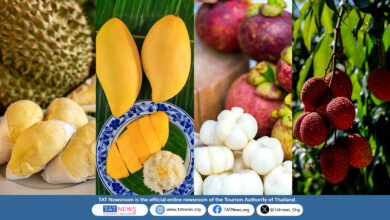Chaiyaphum, in Thailand’s Northeast isn’t the nation’s best known province, despite it being home to some the best national parks – most visitors seem head to nearby regions such as Lop Buri or Khon Kaen. However, Chaiyaphum has a great deal to offer visitors, as I found when I went to explore.

That fact that Chaiyaphum is so-little visited, gives it an air of mystery and charm, you feel much like in intrepid explorer seeing new lands for the very first time. In addition the locals are as interested in you, not being jaded by years of tourism. So it is a friendly and engaging place.
And unlike many provinces in Thailand, the best time to visit is actually during the rainy season, for this is when the province celebrates its famous blooming flower, the Krachiao or Siam Tulip. These lovely flowers, indigenous to Chaiyaphum, are found in the Sai Ngam and Thepsathit National parks and they really are sight to behold, with their purple heads, dancing against the greenery. Every year, photographers flock to the parks on hearing of the first blooming.
With no time for hiking, you can also take in some the Chaiyaphum’s other attractions starting with Mor Hin Khao – listed as of one of the Seven Wonders of Thailand.
Literally meaning “Hill of White Rocks”, Mor Hin Khao is an impressive, if eerie stone formation that has been compared to England’s Stonehenge: though they are the result of long-term geological shifts rather than the work of men.
Found in the Phu Laen Kha National Park, the row of stones are said to glow on auspicious days in the religious calendar, illuminated by the full or waning moons. Formed over millions of years, the rocks were long hidden by thick jungle and later cassava plantations but these have been cleared so people can look around. The main feature is five massive sandstone formations, towering over 12 metres high. Camping is allowed for a sighting experience in the moonlight although facilities are basic.
After seeing the stones, you can then head to Tad Ton National Park, stopping off to dine at a restaurant with a view of the impressive Lam Pathao Dam. The owner will probably tell you that you have to see Wat Arun Dhamma Sathan as “it’s a lovely temple, well worth seeing. Not many people know it, but it’s the sister temple to Bangkok’s Wat Arun.”
It seems that Chaiyaphum has many forest monasteries, so, if you are eager to see this northern Wat Arun, you should set off into the hills. It’s a lovely journey with wide vistas of fruit plantations where pineapples and dragon fruits grow. There are also a few chic looking resorts nestling alongside more traditional Thai housing. It is an idyllic spot.
Wat Arun Dhamma Sathan is lovely and a popular pilgrimage centre. It’s a bit of a climb to the top, with its striking white pagoda but the view is great. From the pagoda you can enjoy views of the impressive Phetchabun mountain range that divides this region in two. The mountains look lush, green and inviting – a perfect place to hike.
The temple isn’t quite finished yet, though it is easy to see echoes of Bangkok’s famous Wat Arun, and there is some striking architecture. The work is being done under the patronage of Princess Soamsawali and is expected to be finished by 2016.
After our temple diversion, you can continue to Tad Ton National Park, one of the four in Chaiyaphum. The national park takes in the Phu Laen Kha mountain range. The highest peak here, at 945 metres, is Phu Laen Kha itself. These hills feed the region’s important rivers and there are some lovely waterfalls to see, the most famous being Tad Ton waterfall which gently cascades over wide rock plateaus where you can bathe and cool off.
Tad Ton is a popular spot at the hottest part of the year, during the Songkran festival when people come to splash and swim, enjoy the scenery and to simply relax. But to see the waterfall in a more dramatic manner, come between June and September when heavy rains fuel the rivers, and thousands of gallons of water a second plunge over the falls.
In fact, the rainy season really is the best time to visit Chaiyaphum – the heat isn’t overbearing, cooling drizzles add great colour to the flowers and fauna and the lovely national parts are at their most lush. Who knows for you may will be back next year with your hiking boots to see the famous tulips. Chaiyaphum’s secret is out.
Getting there:
Chaiyaphum’s main town is 333km from Bangkok.
By car: Take Highway 1 (Phahonyothin Rd) from Bangkok to Saraburi. Turn right onto Highway 2 (Mittraphap Rd) and turn left into Highway 201 at Sikhio district, passing Dan Khun Thot and Chatturat Districts into Chaiyaphum.
By bus: There are several buses a day from Bangkok to Chaiyaphum and the journey takes around 5 ½ hours. For more information, contact the Bangkok Bus Terminal (Mo Chit 2) at Tel. 0 2936 2852-66 or Chaiyaphum Bus Terminal at Tel. 0 4481 1493. Since August 2014, there has been a VIP bus from running from Mo Chit for B320/B275.
You can also take buses from Khon Kaen, which leave every hour and cost B90. Winding roads mean the trip takes 2.5 hours.





